Popular Trekking Routes in Nepal during the Autumn Season
The Everest Base Camp Trek is a renowned hiking trail in Nepal, that leads adventurers to the base camps of Mount Everest, the highest mountain globally, offering a challenging yet gratifying journey spanning approximately 12-14 days. Beginning in the town of Lukla, the trail begins through stunning mountain landscapes, encompassing picturesque valleys, ancient monasteries, and traditional Sherpa villages, where trekkers can immerse themselves in the unique culture and hospitality of the Sherpa people residing in the Everest region.
As altitude increases, the terrain becomes increasingly rugged and dramatic, offering spectacular views of towering snow-capped peaks. The highlight of the trek is reaching Everest Base Camp, situated at an altitude of around 5,364 meters (17,598 feet), allowing trekkers to admire the awe-inspiring sight of Everest's massive peak up close. Although physically demanding due to high altitudes, the trek promises an unforgettable adventure for those craving an authentic mountain experience in the Himalayas.
Major Highlights and Attraction of Everest Base Camp Trek
- Breathtaking mountain views of the world's highest peaks, including Mount Everest (8,849 m/29,032 ft), Lhotse (8,516 m/27,940 ft), Nuptse (7,861 m/25,791 ft), and Ama Dablam (6,812 m/22,349 ft).
- Reaching Everest Base Camp (5,364m) and witnessing the base camp used by Everest climbers.
- Immersion in the Sherpa culture and experiencing their warm hospitality and rich traditions.
- Exploring Namche Bazaar, the vibrant "Gateway to Everest," with a blend of Tibetan and Nepalese cultures.
- Trekking to Kala Patthar (5,545m) for stunning up-close views of Everest and surrounding peaks.
- Visiting ancient monasteries like Tengboche and witnessing Buddhist rituals and practices.
- Challenging terrain with suspension bridges, rocky paths, and glacial moraines.
- Gradual acclimatization and trekking through high altitudes.
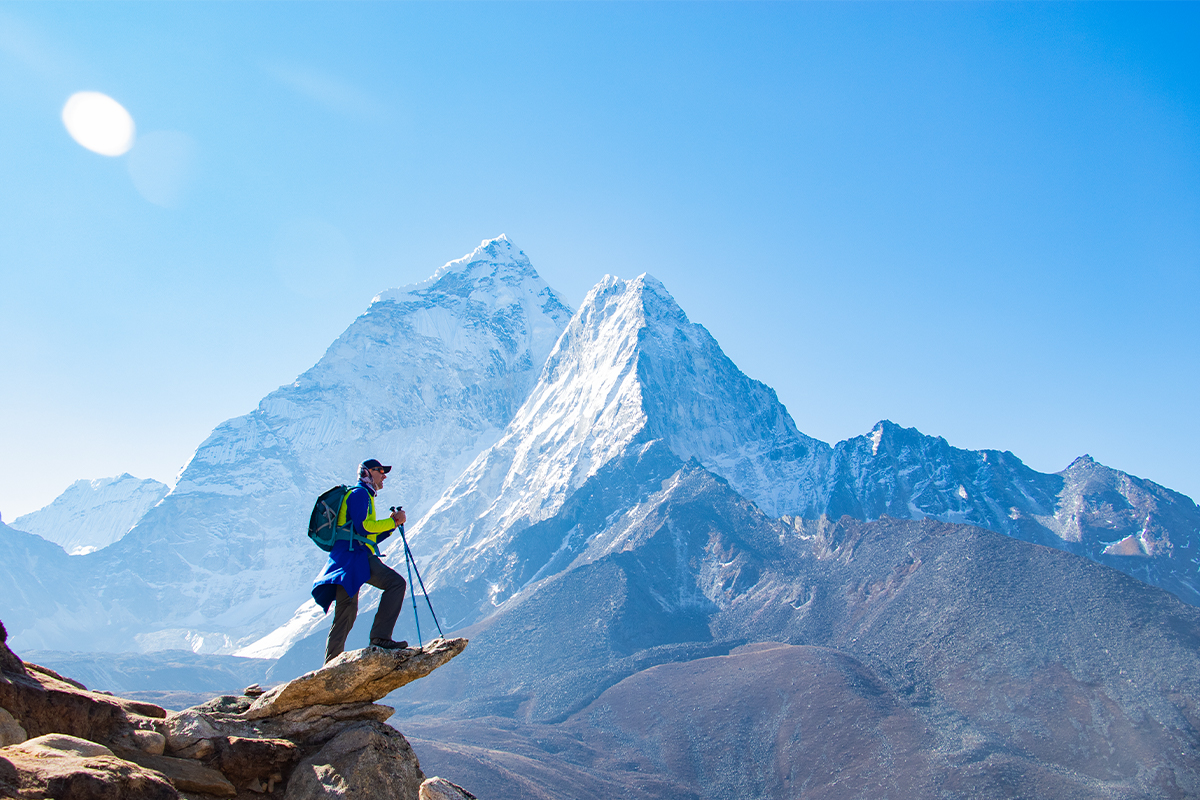
Brief Itinerary of Everest Base Camp Trek
Day 1:Arrival in Kathmandu and Transfer to Hotel
Day 2:UNESCO World Heritage Site Excursion
Day 3:Fly to Lukla & Trek to Phakding
Day 4:Trek to Namche Bazaar
Day 5:Acclimatization in Namche Bazar
Day 6:Trek to Debuche Village
Day 7:Trek to Dingboche Village
Day 8:Acclimatization in Dingboche
Day 9:Trek to Lobuche
Day 10:Trek to Everest Base Camp & Stay at Gorakshep
Day 11:Hike to Kalapatthar & Trek to Pheriche
Day 12:Trek to Namche Bazaar
Day 13:Trek to Lukla Village
Day 14:Fly back to Kathmandu
Day 15:Departure Day
Trekking permits required for Everest Base Camp Trek:
Khumbu Rural Municipality Permit
- Foreign nationals (including SAARC citizens): NPR 2,000 per person for the first 4 weeks
- After 4 weeks: NPR 2,500 per person
Sagarmatha National Park Entry permit
- Foreign nationals: NPR. 3,000 per person
- SAARC nationals: NPR. 1,500 per person
- Nepali citizens: NPR. 100 per person
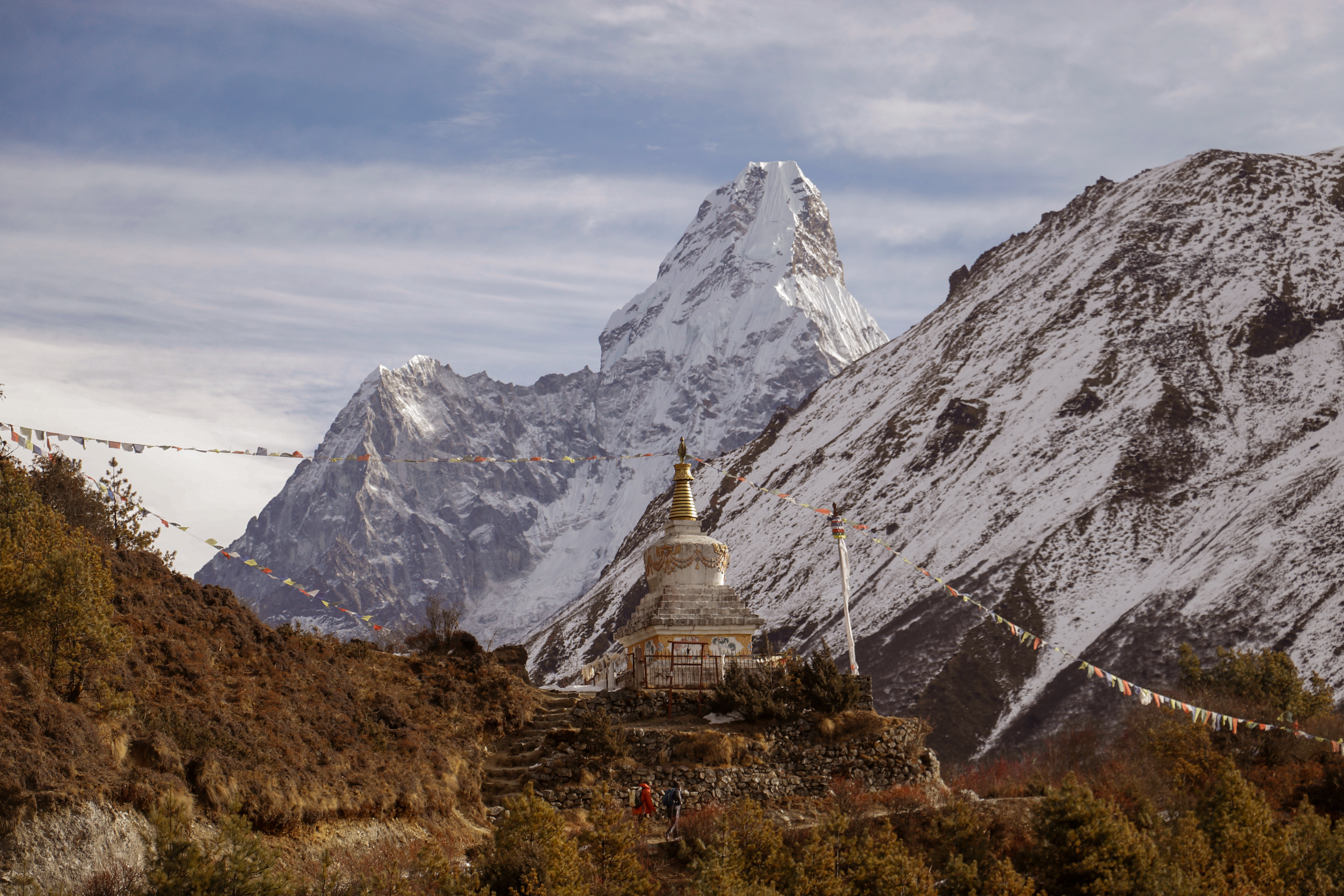
The Annapurna Circuit Trek, a renowned hiking trail in Nepal’s Annapurna region, encircles the majestic Annapurna mountain range. A highlight of this trek is the side trip to Tilicho Lake, one of the highest lakes in the world at an elevation of 4,919 meters (16,138 feet). Reaching Tilicho Lake involves trekking through breathtaking high-altitude landscapes with awe-inspiring views of the Annapurna peaks. This brilliant turquoise lake holds religious significance for Hindus and Buddhists, who undertake pilgrimages here. Combining the incredible scenery of Tilicho Lake with the already amazing Annapurna Circuit Trek offers an unparalleled adventure for nature enthusiasts. The journey also takes trekkers over Thorangla Pass, one of the world's highest passes at 5,416 meters, providing thrilling experiences and spectacular mountain vistas. Here, is a complete guidebook for Tilicho Lake for you.
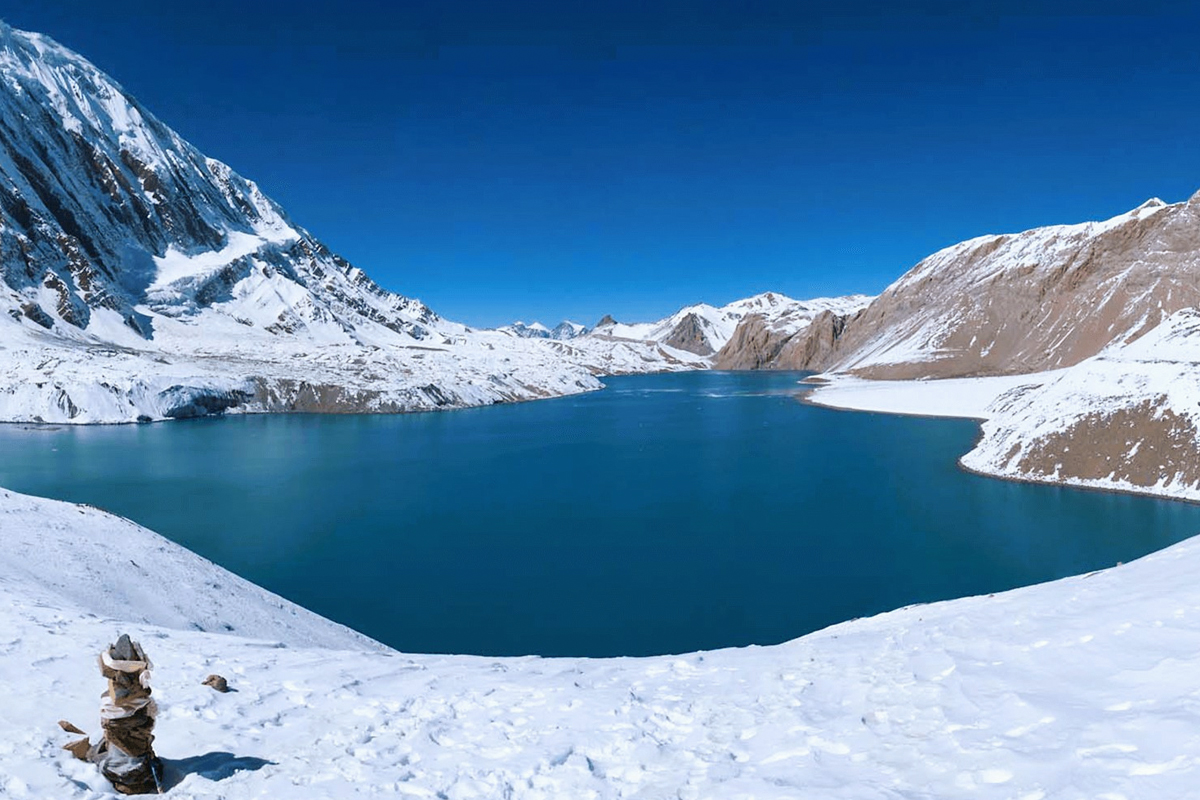
Major Highlights and Attractions of Annapurna Circuit Trek
- Crossing Thorong La Pass, the highest pass in the world at an elevation of 5,416 meters (17,769 feet), offers an exhilarating challenge.
- Visiting Tilicho Lake, one of the highest lakes in the world at an elevation of 4,919 meters (16,138 feet), known for its brilliant turquoise color and stunning mountain surroundings.
- Exploring the historic sacred Muktinath Temple, equally important for Hindu and Buddhist religions, immersing in the region's spiritual significance.
- Witnessing the awe-inspiring Gangapurna Lake at an elevation of 3,540 meters.
- Trekking through yak pastures, grazing lands, and farmlands, experiencing the traditional way of life in the region.
- Enjoying stunning views of beautiful snow-capped mountains, including the Annapurna range, Thorong Peak, Manaslu, Gorkha Himal, Lamjung Himal, Dhaulagiri, Tukuche Peak, Nilgiri, and Machapuchhre, surrounded by breathtaking natural beauty.
- Experiencing the unique Tibetan Buddhist culture prevalent in the region, including visits to ancient monasteries and interactions with local communities, immersing in the rich cultural heritage.

Brief Itinerary of Annapurna circuit trek with Tilicho Lake
Day1:Arrival in Kathmandu City and Transfer to Hotel
Day 2:Kathmandu City Tour, Pre-Trek Briefing, and Welcome Dinner
Day 3:Drive to Chame via Besisahar in Private Scorpio
Day 4:Trek to Upper Pisang
Day 5:Trek to Manang Village
Day 6:Acclimatization Day at Manang
Day 7:Trek to Shreekharka
Day 8:Trek to Tilicho Base Camp
Day 9:Trek to Tilicho Lake and return to Shreekharka
Day 10:Trek to Yak Kharka
Day 11:Trek to Thorong Phedi
Day 12:Trek to Muktinath Village via Thorong La Pass
Day 13:Trek to Jomsom Village
Day 14:Drive back to Pokhara in Private Scorpio
Day 15:Fly back to Kathmandu
Day 16:Departure Day
Trekking permits required for the Annapurna Circuit Trek:
TIMS Card
- SAARC Countries: NPR 1000
- Other Countries: NPR 2000
ACAP
- SAARC Countries: NPR 1000
- Other countries: NPR 3000
The Nar Phu Valley Trek captivates adventurers with its relatively unexplored terrain in the remote Annapurna region of western Nepal. This unique trek takes explorers through stunning landscapes, from lush rhododendron forests and terraced fields to high-altitude deserts and rugged mountains, while providing an authentic glimpse into the traditional Tibetan Buddhist culture of the Narphu and Lhomi people. Trekkers will cross several high passes, including the Kang La Pass making it a moderate to challenging journey that demands good physical fitness and acclimatization. As a restricted area, a special permit and a licensed guide are required to preserve the region's unique culture and environment. The Nar Phu Valley Trek offers an unparalleled opportunity to immerse in the rich cultural heritage of this remote Himalayan region while challenging amidst breathtaking mountain landscapes.
Major Highlights and Attractions of Narphu Valley Trek
- The Nar Phu Valley remained restricted to outsiders until 2002, making it one of the least explored areas in Nepal and offering a true off-the-beaten-path experience.
- The trek involves undertaking high-altitude trekking, crossing several high mountain passes, including the Kang La Pass (5,322m/17,460ft), and providing a challenging experience.
- Ancient monasteries and chortens (Buddhist stupas) can be explored, such as the Luri Gompa and Nar Monastery, where one can witness the unique architecture and religious significance of the region.
- The trek takes one through picturesque stone-walled villages, such as Nar and Phu, offering a glimpse into the traditional way of life in the Himalayas.

Brief Itinerary of Nar Phu Valley Trek
Day 1:Arrival in Kathmandu
Day 2:Kathmandu City Tour & Pre-trek Preparation
Day 3:Drive to Besisahar Lamjung
Day 4:Drive to Dharapani/Koto
Day 5:Trek to Meta
Day 6:Trek to Phu Gaun
Day 7:Acclimatization Day
Day 8:Trek to Nar Phedi
Day 9:Trek to Nar Gaun
Day 10:Trek to Ngawal Valley via Kangla Pass
Day 11:Trek to Manang Village
Day 12:Drive back to Besisahar
Day 13:Drive back to Kathmandu
Day 14:Final Departure
Trekking Permits required for Nar Phu Valley Trek:
Special Restricted Area Permit (RAP)
- December to August: USD 75 per person for the first 7 days, and USD 15 additional charge per person per day after the 7th day.
- September to November: USD 100 per person for the first 7 days, and USD 15 additional charge per person per day after the 7th day.
- Annapurna Conservation Area Project (ACAP) Permit
- USD 30 per person for a single entry, valid for an unlimited number of days.
Trekkers' Information Management System (TIMS) Permit (required if extending the trek to the Annapurna Circuit)
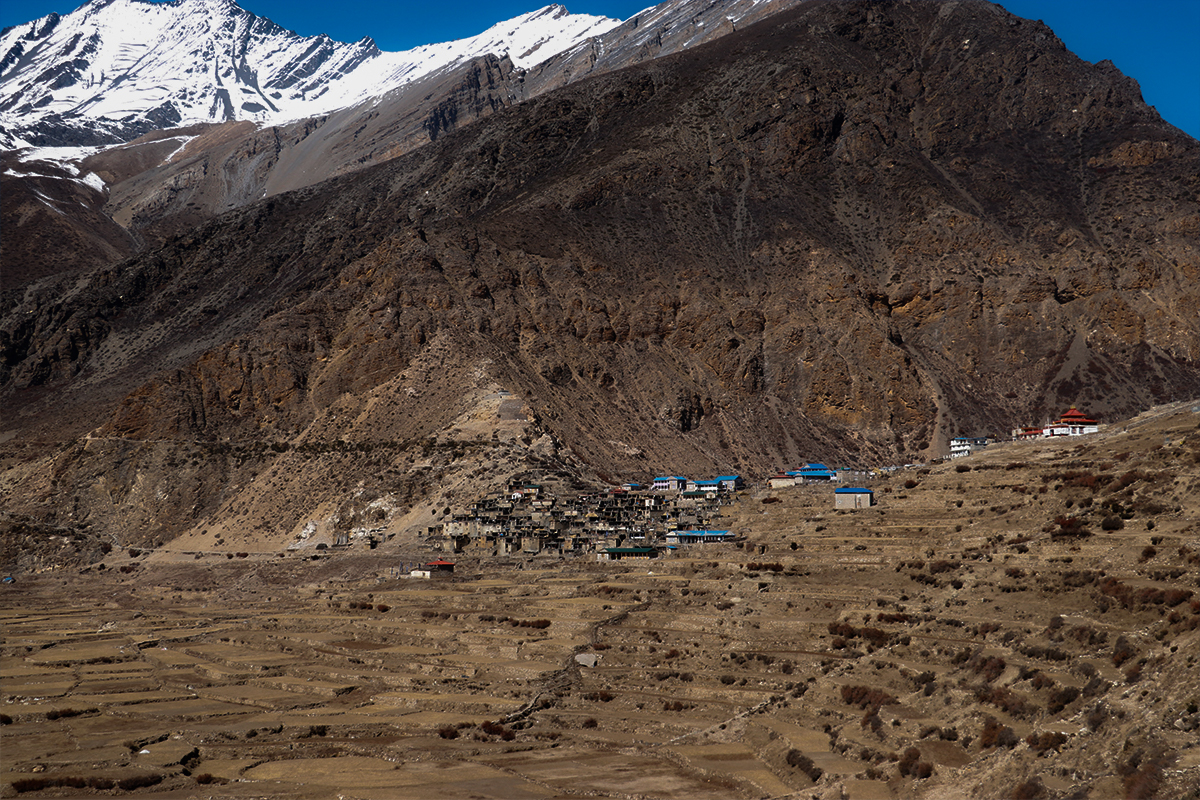
One of the well-liked and best treks in Nepal is the Ghorepani Poonhill Trek. It takes trekkers through charming villages, and lush rhododendron forests, and offers stunning views of the Annapurna mountain range. The highlight of the trek is Poon Hill, a famous viewpoint at an altitude of 3,210 meters. From Poon Hill, one can witness breathtaking sunrise and sunset views over the Himalayas, including the massive peaks of Annapurna I, Dhaulagiri, and Machhapuchhre. The trek starts from Nayapul or Birethanti and follows a well-marked trail through villages like Ghorepani and Ghandruk, where trekkers can experience the rich culture and hospitality of the Gurung people. The trail passes through forests of rhododendrons, which bloom with vibrant colors in spring. With a maximum altitude of around 3,210 meters, the Ghorepani Poonhill Trek is suitable for those with a moderate level of fitness. The trek offers basic teahouse accommodation and delicious Nepali cuisine along the way, making it a comfortable yet adventurous experience.
Major Highlights and Attractions
- Panoramic views of the Annapurna range, including Annapurna I (8,091m), Dhaulagiri (8,167m), Machhapuchhre (6,993m), and more.
- The famous Poon Hill (3,210m) offers breathtaking sunrise and sunset views over the Himalayas.
- The trek passes through lush rhododendron forests, which bloom in spring with vibrant red and pink flowers.
- Gurung villages: Experience the rich culture and hospitality of the Gurung people in traditional villages like Ghorepani and Ghandruk.
Brief Itinerary of Ghorepani Poon Hill Trek
Day 1:Arrival in Kathmandu
Day 2:Full Day Kathmandu City Excursion
Day 3:Drive from Kathmandu to Pokhara City
Day 4:Drive to Nayapul and trek to Tikhedhunga
Day 5:Trek Tikhedhunga to Ghorepani
Day 6:Hike Ghorepani to Poonhill(3,210m) and trek to Tadapani
Day 7:Trek Tadapani to Ghandruk
Day 8:Trek to Nayapul & Drive to Pokhara
Day 9:Drive from Pokhara to Kathmandu
Day 10:Final Departure

Trekking Permits required for the Ghorepani Poon Hill Trek:
Annapurna Conservation Area Project (ACAP) Permit
- For foreigners: NRs. 3,000 per person per entry
Trekkers' Information Management System (TIMS) Card
- For Foreign Individual Trekkers: NRs. 2,000 per person
- For Foreign Group Trekkers: NRs. 1,000 per person
The Langtang Valley Trek is famous in Nepal's Langtang National Park, around 60 km north of Kathmandu. It combines cultural discovery with stunning natural scenery. The trek starts in the small town of Syabru Besi, reached by a scenic drive from Kathmandu. From there, the trail climbs through beautiful forests of rhododendrons, oak, and pine trees to reach the high villages of the Tamang people. Along the way, you'll see amazing views of Langtang Lirung (7,246m) and other majestic peaks.
One highlight is Kyanjin Gompa, a peaceful monastery at 3,870m with panoramic mountain and glacier views - a great spot to rest and explore. The trek also offers chances to see wildlife like the rare red panda, Himalayan tahr, and many bird species. The pristine Langtang River runs alongside the trail for much of the way, adding to the natural beauty. This is considered a moderate to challenging 7-10 day trek, suitable for fairly fit people. The combination of cultures, scenery, and wildlife makes it a classic Himalayan adventure.
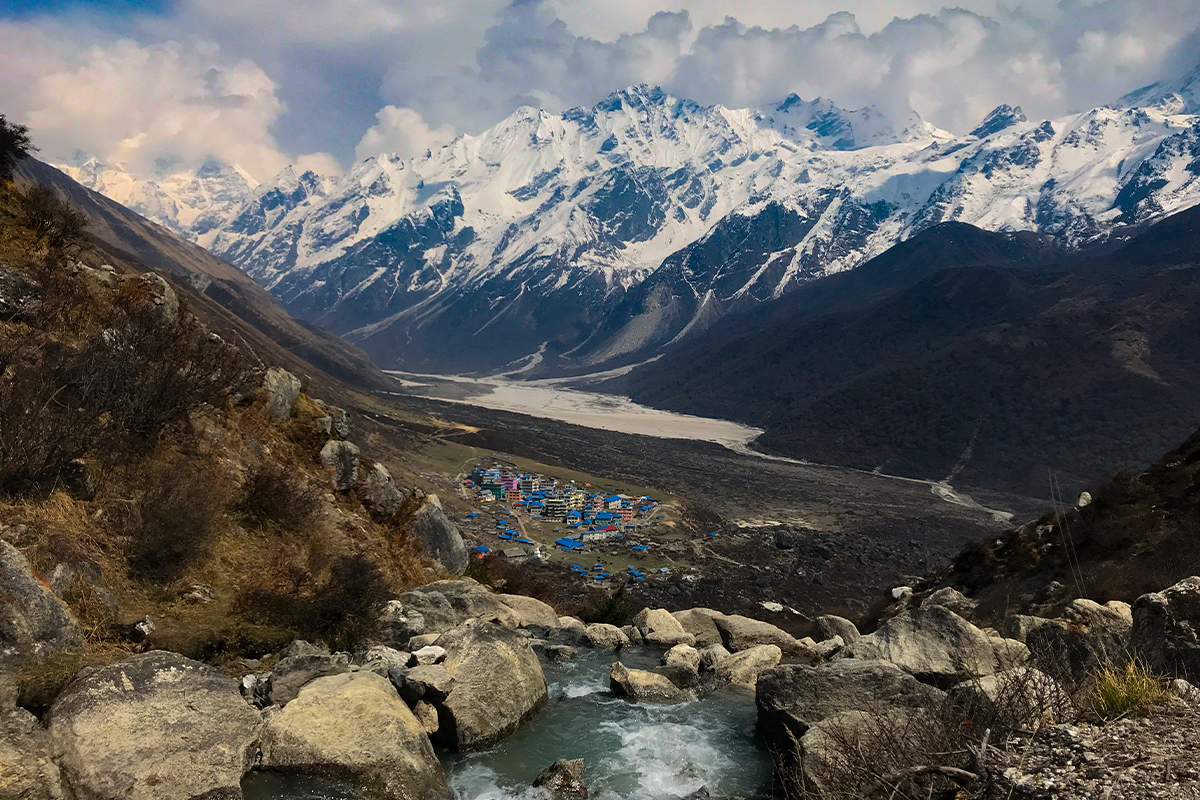
Major Highlights and Attractions of Langtang Valley Trek
- Explore the traditional Tibetan-style village of Langtang, with its stone houses, monasteries, and rich cultural heritage.
- Visit the ancient Kyanjin Gompa, a Buddhist monastery located at an altitude of 3,870 meters, surrounded by towering peaks.
- Enjoy the spectacular views of the Langtang Lirung (7,246m), Ganchhenpo (6,388m), Naya Kanga (5,846m), and other peaks in the Langtang range.
- Witness the impressive Langtang Glacier and the turquoise glacial lakes, such as Dudhkoshi and Gosainkunda.
- Trek through lush rhododendron forests, bursting into vibrant colors during spring.
- Visit traditional cheese factories in villages like Kyanjin Gompa and learn about the local cheese-making process.
- Experience the unique culture and hospitality of the Tamang and Tibetan Buddhist communities living in the region.
Brief itinerary of Langtang Valley Trek
Day 1:Arrival in Kathmandu City
Day 2:UNESCO World Heritage Site Excursion in Kathmandu
Day 3:Drive to Syabrubesi, Rasuwa
Day 4:Trek to Lama Hotel
Day 5:Trek to Langtang Village
Day 6:Trek to Kyanjin Gompa
Day 7:Hike to Tserko Ri and back to Kyanjin Gompa
Day 8:Trek back to Lama Hotel
Day 9:Trek back to Syabrubesi, Rasuwa
Day 10:Drive back to Kathmandu
Day 11:Departure Day
Trekking Permit Required for Langtang Valley Trek:
Trekkers' Information Management System (TIMS) Card
- For Nepali:100 NPR. (about USD 1).
- For SAARC nationals: 1,500 NPR. (about USD 15).
- For other Foreign nationals: 3,000 NPR (roughly USD 30).
The Mardi Himal Trek is a relatively new and off-the-beaten path in the Annapurna region of Nepal. This moderate trek takes you through traditional Gurung villages, and dense rhododendron forests, and offers stunning views of the iconic Annapurna, Machhapuchhre, and Mardi Himal peaks.
The Trek begins near Phedi village in the Annapurna Conservation Area. As you ascend through the lush forests, you'll catch glimpses of the towering Mardi Himal (5,587m) and other massive peaks. The trail leads you to low-altitude temporary settlements used by local Gurung people for grazing livestock during the summer months.
The highlight of the trek is reaching the high camp at an elevation of around 4,500m, which offers a breathtaking up-close view of the Mardi Himal massif and the surrounding glaciers. The trek's highest point is at an altitude of around 4,800m, providing a truly mesmerizing panorama of the Annapurna range. With its moderate difficulty level, the Mardi Himal Trek is a great alternative for those seeking a quieter and less crowded experience compared to the popular Annapurna Base Camp Trek.
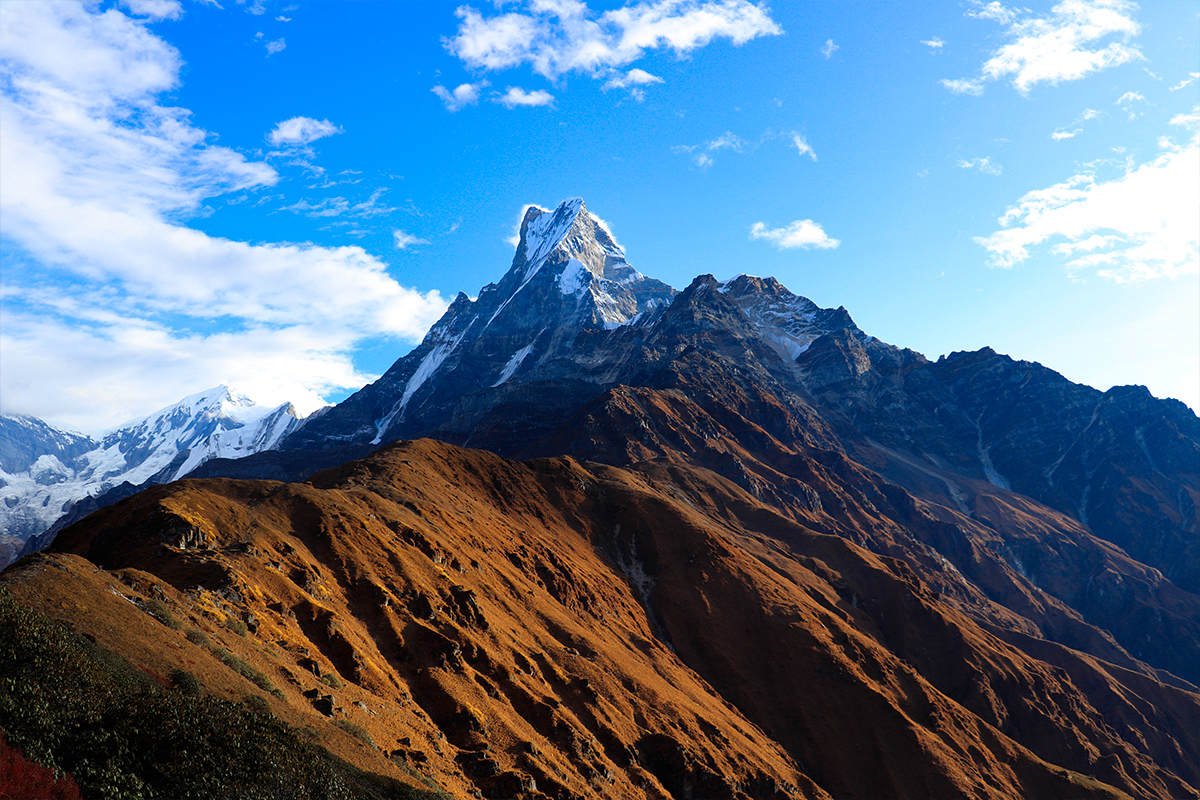
Major highlights and attractions of Mardi Himal Trek
- Breathtaking mountain views, including Mardi Himal, Machhapuchhre, and Hiunchuli peaks
- High-altitude viewpoints at Mardi Himal Base Camp and High Camp for panoramic peak views
- Trekking through lush rhododendron forests in spring
- Diverse landscapes from green valleys to waterfalls and rugged terrain
- Cultural immersion in traditional Gurung and Magar villages
- Moderate to strenuous difficulty level, suitable for fit trekkers
- Fewer crowds compared to popular Annapurna treks, offering a peaceful experience
Brief itinerary of Mardi Himal Trek
Day 1: Arrival in Kathmandu City
Day 2: UNESCO World Heritage Site Excursion
Day 3: Drive from Kathmandu to Pokhara
Day 4: Drive from Pokhara to Phedi / Kande and trek to Pothana Village
Day 5: Trek to Forest Camp
Day 6: Trek to Low Camp
Day 7: Trek to Mardi High Camp
Day 8: Hike to Mardi Viewpoint and Mardi Base Camp
Day 9: Trek to Siding Village and Drive to Pokhara
Day 10: Drive or fly back to Kathmandu
Day 11: Departure Day
Trekking permits required for Mardi Himal Trek:
Trekkers' Information Management System (TIMS) Card
- For foreign nationals - NPR 2000
Annapurna Conservation Area Project (ACAP) Entry Permit
- During the high season (March to May and October to November)- NPR 3,000 per person
- During the low season (June to September and December to February)- NPR 2,000
The Everest Three Passes Trek is an incredibly scenic and challenging trek in the Everest region of Nepal. It is considered one of the most beautiful and strenuous treks in the Himalayan region. This trek takes trekkers over three high passes - Renjo La (5,360m), Cho La (5,420m), and Kongma La (5,535m) - offering breathtaking views of Mt. Everest, Lhotse, Makalu, and other towering peaks.
The journey begins with a flight to Lukla and follows the classic Everest Base Camp route until Dingboche. From there, trekkers ascend the Renjo La pass, crossing into the remote Gokyo Valley, where they get to witness the stunning Gokyo lakes and the massive Ngozumpa Glacier.
After crossing the Cho La and Kongma La passes, trekkers descend to the Khumbu Valley, where they get to visit the iconic Everest Base Camp and the historic Khumbu Glacier. The trek offers an opportunity to experience the unique Sherpa culture and explore the rugged and untouched landscapes of the Himalayan region.
With its high altitude, challenging terrain, and remote locations, the Everest Three Passes Trek is suitable for experienced trekkers with excellent physical fitness. It is a true adventure that rewards trekkers with some of the most magnificent mountain vistas in the world.
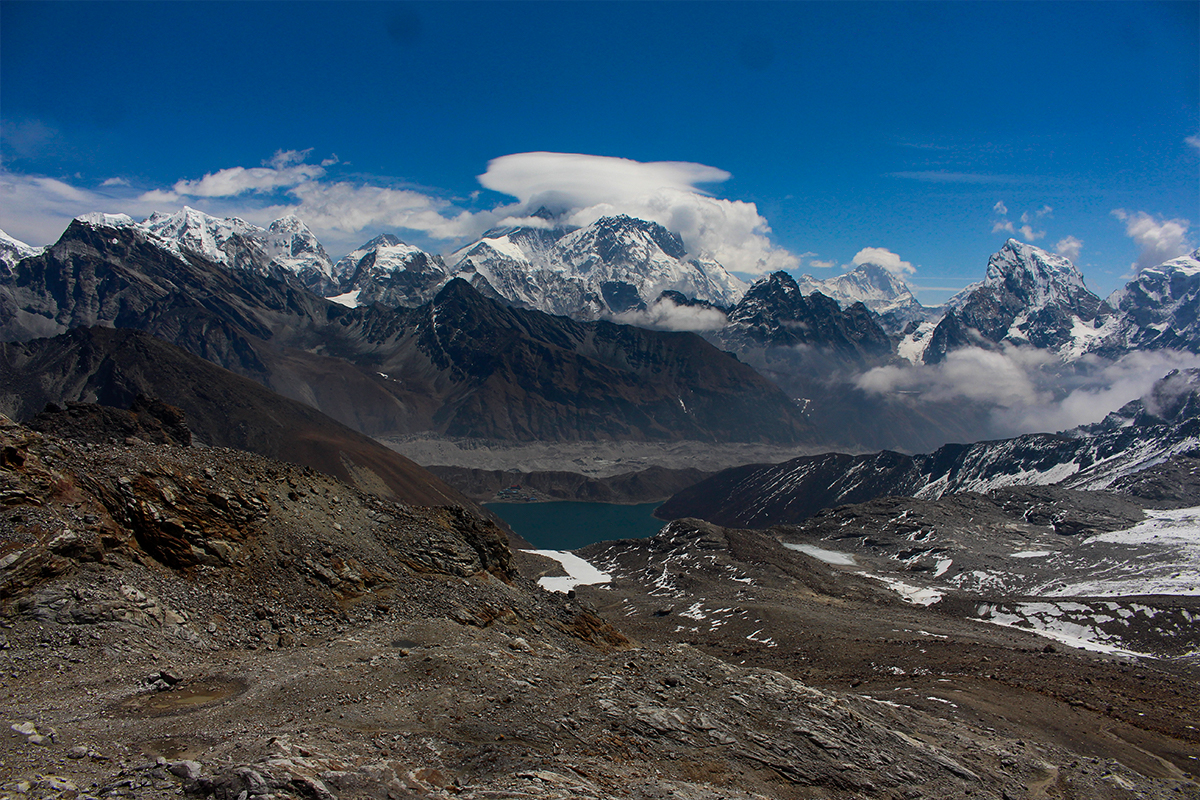
Major Highlights and Attractions of Everest Three Pass Trek
- Crossing three high passes: Renjo La (5,360m/17,585ft), Cho La (5,420m/17,782ft), and Kongma La (5,535m/18,159ft)
- Stunning views of Mt. Everest (8,848m/29,029ft), Lhotse (8,516m/27,940ft), Nuptse (7,861m/25,791ft), and other Himalayan giants
- Exploring the Sherpa culture and visiting monasteries like Tengboche and Pangboche
- Trekking through the Khumbu Glacier and Everest Base Camp (5,364m/17,598ft)
- Experiencing the vibrant Sherpa towns of Namche Bazaar and Khumjung
- Trekking through the remote and scenic Gokyo Valley and its turquoise lakes
Brief Itinerary of Everest Three Passes Trek
Day 1:Arrival in Kathmandu & Transfer to Hotel
Day 2:Kathmandu Valley Sightseeing
Day 3:Fly to Lukla & Trek to Phakding
Day 4:Trek to Namche Bazaar
Day 5:Acclimatization in Namche Bazaar
Day 6:Trek to Thame Village
Day 7:Trek to Lungden Village
Day 8:Trek to Gokyo Village via Renjola Pass
Day 9:Hike to Gokyo Ri and back to Gokyo Village
Day 10:Trek to Thangnak Village
Day 11:Trek to Dzongla via Chola Pass
Day 12:Trek to Lobuche Village
Day 13:Trek to Everest Base Camp via Gorakshep
Day 14:Hike to Kalapatthar & Trek back to Lobuche
Day 15:Trek to Chukung Ri via Kongmala pass
Day 16:Trek to Pangboche Village
Day 17:Trek to Namche Bazaar
Day 18:Trek to Lukla
Day 19:Fly back to Kathmandu
Day 20:Leisure Day & Farewell Day
Day 21:Departure Day
Trekking permits required for Everest Three Passes Trek:
Sagarmatha National Park Entry Permit
Khumbu Pasang Lhamu Rural Municipality Entry Permit
The Manaslu Circuit Trek is a challenging yet rewarding trek that takes you around the eighth-highest mountain in the world, Mt. Manaslu (8,163m), in the Gorkha region of Nepal. This off-the-beaten-path trek offers a unique experience of traversing through remote villages, crossing high mountain passes, and witnessing the natural wonder of the Himalayan mountains. Which voice is this in active or passive
The trek begins in the historic town of Gorkha and follows the Budhi Gandaki River Valley, passing through traditional Nubri and Tsum villages, where you can immerse yourself in the local culture and way of life. As you ascend, you'll be treated to stunning views of Mt. Manaslu, Himchuli, and other snow-capped peaks.
One of the highlights of the trek is crossing the challenging Larkya La pass (5,160m), which offers a breathtaking panorama of the Manaslu range and the surrounding glaciers. Descending from the pass, you'll enter the Marsyangdi Valley and traverse through the lush Annapurna Circuit region, passing
Recognized as one of Nepal's most challenging treks due to its remote location, high altitudes, and rugged terrain, the Manaslu Circuit Trek rewards adventurers with an unparalleled wilderness experience, cultural richness, and stunning mountain vistas, making the effort truly worthwhile.

Major Highlights and Attractions of Manaslu Circuit Trek
- Trekking around the massive Manaslu (8,163m/26,781ft), the eighth-highest mountain in the world.
- Crossing the challenging Larkya La Pass (5,160m/16,928ft
- Exploring the ancient salt trade route between Nepal and Tibet
- Experiencing the unique Tibetan Buddhist culture of the Nubri Valley
- Visiting the remote and isolated villages of Samagaun and Samdo
- Trekking through the lush Budhi Gandaki River Valley
- Enjoying the dramatic landscapes of glaciers, high passes, and rugged mountains.
- Observing diverse flora and fauna, including the legendary yaks and blue sheep
Brief Itinerary of Manaslu Circuit Trek
Day 1:Arrival in Kathmandu
Day 2:UNESCO World Heritage Site Excursion
Day 3:Drive to Soti Khola
Day 4:Trek to Machha Khola
Day 5:Trek to Jagat
Day 6:Trek to Deng
Day 7:Trek to Namrung Village
Day 8:Trek to Shyala Gaun
Day 9:Trek to Sama Gaun
Day 10:Acclimatization Day
Day 11:Trek to Samdo
Day 12:Trek to Dharmasala
Day 13:Trek to Bimthang via Larkey Pass
Day 14:Trek to Dharapani
Day 15:Drive to Besi Sahar
Day 16:Drive back to Kathmandu
Day 17:Departure Day
Trekking permits required for Manaslu Circuit Trek:
Manaslu Restricted Area Permit
- For Autumn (Sep-Nov): $100 for the first 7 days, $15 for each additional day
- For other seasons (Dec-Aug): $75 for the first 7 days, $10 for each additional day
Manaslu Conservation Area Permit (MCAP)
- Cost for SAARC nationals: NPR 1000 per person
- Cost for other nationals: NPR 3000 per person
Annapurna Conservation Area Permit (ACAP)
- Cost for SAARC nationals: NPR 1000 per person
- Cost for other nationals: NPR 3000 per person
Additionally, if you plan to extend the trek to Tsum Valley, you need to obtain a separate Tsum Valley Permit for $35 per person for one week.
The Upper Dolpo Trek is challenging but very rewarding in a remote part of northwestern Nepal. This isolated area is surrounded by high mountains and has a dry, desert-like landscape similar to Tibet.
Dolpo is one of the most unspoiled and culturally rich regions in Nepal because it was cut off from the outside world for a long time. The local people, called the Dolpo-pa, are descendants of Tibetans and have maintained their unique Buddhist traditions and way of life for centuries.
The trek takes you through desolate valleys, over high mountain passes up to 5,300 meters, and into ancient villages where traditional Tibetan culture still thrives today. Trekkers are treated to incredible views of massive snow-capped peaks, crossed by yak caravans on ancient salt trading routes from Tibet.
Only a limited number of trekking permits are given out each year, so Upper Dolpo remains an off-the-beaten-path destination. The trek involves crossing several very high mountain passes over 5,000m, so trekkers need to be properly acclimatized. But the rewards include amazing Himalayan scenery and an authentic experience in one of the last places where ancient Buddhist culture still exists.
Major Highlights and Attractions of Upper Dolpo Trek
- Visiting a very remote region of Nepal, close to the Tibetan border.
- Experiencing the unique culture and way of life of the Dolpo-pa people, who follow Tibetan Buddhist traditions.
- Exploring ancient villages and monasteries with traditional Tibetan architecture.
- Trekking through dramatic, desert-like landscapes with high cliffs, deep valleys, and canyons.
- Crossing several very high mountain passes, over 5,000 meters high, with incredible mountain views.
- Hiking along the beautiful turquoise Shey Phoksundo Lake, one of Nepal's highest lakes.
- Following the old salt trading routes that connected Nepal and Tibet.
- Experiencing the warm hospitality of the local Dolpo-pa people in their remote villages.
- Possibility of seeing rare Himalayan wildlife like blue sheep and musk deer.
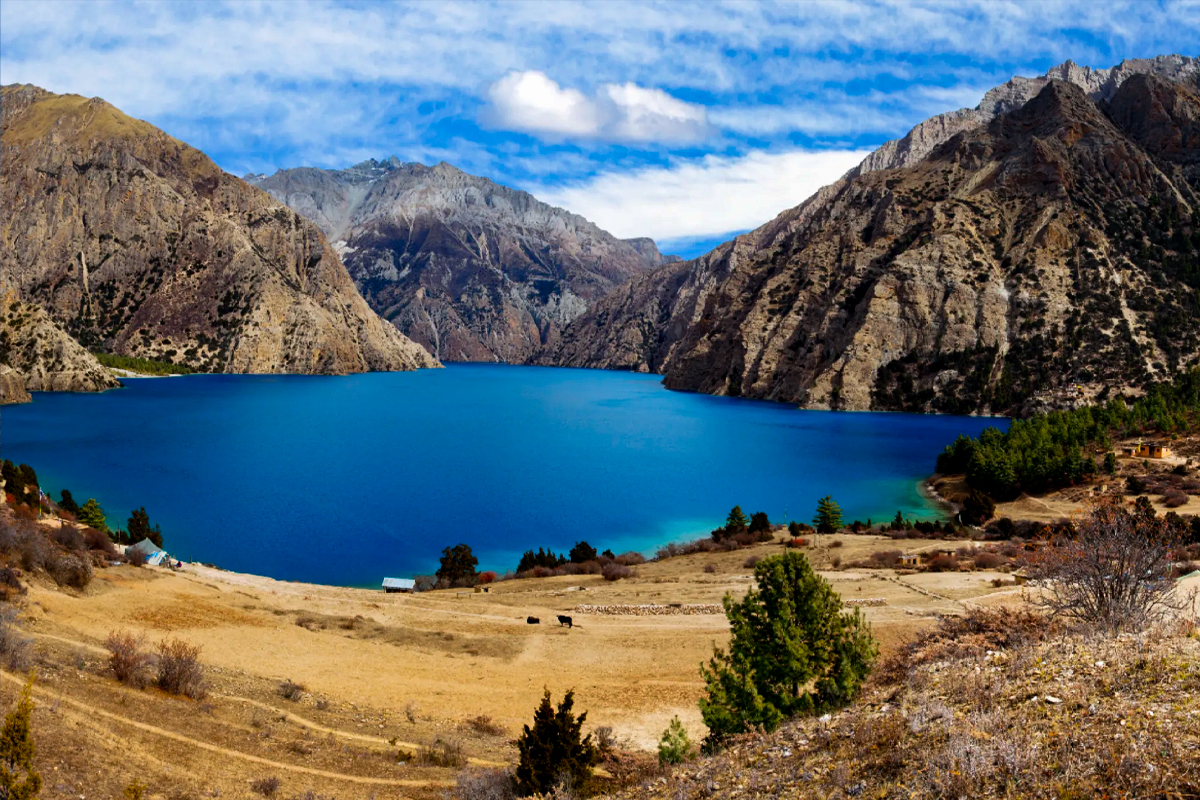
Brief Itinerary of Upper Dolpo Trek
Day 1:Kathmandu arrival and hotel transfer
Day 2: Kathmandu city tour and trek briefing
Day 3: Flight to Nepalgunj
Day 4:Arrival at Juphal and trek to Dunai
Day 5: Dunai to Laina Odar
Day 6: Journey continues to Nawarpani
Day 7: Nawarpani to Langa Camp
Day 8:Trek to Dho Tarap
Day 9: Rest day at Dho Trap
Day 10:Dho Tarap to Chhoila Khola Camp
Day 11:Chhoila Bhanjyang (Pass) to Sulung Khola Camp
Day 12: Sulung Khola Camp to Tinjegaon
Day 13:Tingegaon to Shimengaon
Day 14:Shimengaon to Nisalgaon
Day 15:Rest day at Nisalgaon
Day 16:Nisalgaon to Saldang
Day 17:Saldang to Namgung
Day 18:Namgung to Sheygaon via Sela Pass
Day 19:Rest day at Sheygaon
Day 20:Sheygaon to Phoksundo River Camp
Day 21: River Camp I to River Camp II
Day 22:River Camp II to Ringmo Village
Day 23: Rest day at Ringmo Village
Day 24:Ringmo to Chhepka
Day 25:Chhepka to Juphal
Day 26: Flight back to Nepalgunj
Trekking permits required for Upper Dolpo Trek
Upper Dolpo Restricted Area Entry Permit
- Cost: USD 500 per person for the first 10 days
- Additional cost: USD 50 per person per day for additional days beyond 10 days
Two Lower Dolpo Restricted Area Entry Permits
- Cost: USD 40 (USD 20 per permit)
- One permit is required to enter Lower Dolpo before going to Upper Dolpo
Another permit is required to re-enter Lower Dolpo after completing the Upper Dolpo trek
Shey-Phoksundo National Park Permit
- Cost: USD 30 per person (no time limit)
Conclusion
Trekking in Nepal during the autumn season from September to November is considered the best time due to favorable weather, fewer crowds, and beautiful fall colors. Many popular trekking routes are available like Everest Base Camp, Annapurna Circuit, Ghorepani Poon Hill, Langtang Valley, and others. Each trek offers unique highlights such as crossing high mountain passes, exploring villages and monasteries, seeing stunning mountain views, and experiencing local cultures. However, proper preparation is needed including obtaining required trekking permits, hiring guides, having the right gear, and being physically fit for the high altitudes. While trekking can be challenging, it allows you to experience the incredible natural beauty and cultural richness of the Himalayan mountains in Nepal.

.jpg)












